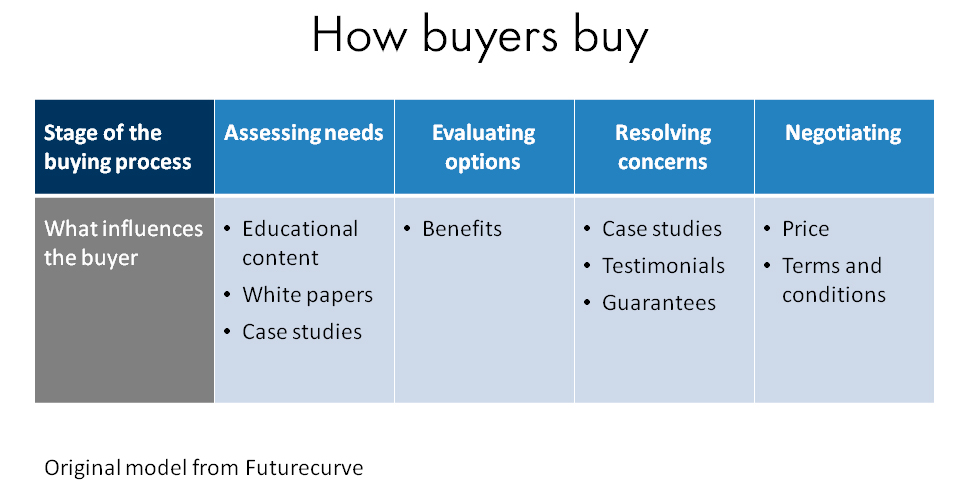One of the great things about being a copywriter is learning from your clients. The following was shared with me by Cindy Barnes at Futurecurve. It explains the process buyers go through when they’re deciding what to buy and – crucially from a copywriting perspective – what influences them at each stage.
This information can help copywriters guide clients through the materials they need to convince their customers. It’s also helpful for copywriters, when considering how to persuade potential clients to use our services.
What buying decisions are we talking about?
This model doesn’t apply to all buying decisions. One of the big trends in recent years is that selling has polarised into two types – transactional and consultative.
Transactional selling
With transactional selling, customers already know what they want. All they need to do is decide who to buy from, which will come down to price, speed of delivery, convenience and similar factors. Most retailing is built on transactional selling.
Consultative selling
Consultative selling is appropriate when the decision to buy is more complex. Buyers have a need but they might not know how to fulfil it. They might not even be certain that the right product or service exists. The seller therefore acts as a consultant, explaining the buyer’s options and, in the process, setting out the case that the customer should buy from them. This is the process described below.
How buyers buy

Assessing needs
At the start of the process, buyers are trying to figure out what’s available and whether it will solve their problem. The company’s job is to educate them, so customers feel sufficiently informed to move to the next stage.
The company’s website is the obvious place to do this, giving plenty of space to guide customers through the options and the chance to mix copy with video, graphics and pictures.
White papers are another excellent way to inform customers and to demonstrate expertise, without being overtly ‘salesy’. They allow you to address current issues or to go into more depth for the buyer who is hungry for detail.
Blog posts can work in the same way: I know that posts I’ve written on how to get the most from a copywriter have helped me to win business. Good case studies are also invaluable for showing how your products or services work in practice.
Ultimately, the volume and type of information you provide will depend on how much education your customers need. Know your customer, as always, is the basic rule.
Evaluating options
This is the differentiation phase – why customers should choose you instead of the alternatives.
The alternatives include both direct competitors and other uses to which customers can put their money. It’s obvious that your sales training course will compete with other training courses but your customer could instead choose to invest in new salespeople, new software or a complete overhaul of its website and marketing collateral. Why is your product the right choice?
This is where benefits-led copy comes into its own. There’s a vast amount of good advice about how to do this, which I’m not going to repeat here. What’s important, though, is to realise that the benefits you believe your product offers may not be the same as the benefits your customers perceive.
This is the second key thing I learned from Cindy. Customers’ perceptions of value have three elements – rational, emotional and social/political. These elements determine how people choose what to buy, even in B2B markets.
Most companies only focus on the rational element, answering the buyer’s obvious questions, such as:
- Does the product work?
- Will it save me time?
- Will it cut my costs?
- Will it make me money?
This ignores the fact that buyers also have an emotional response (‘How will buying this product make me feel?’) and a social/political response (‘How will it make me look to other people?’). Buyers may not even be aware that they are having these responses but they are an inevitable part of the way we make purchasing decisions.
Don’t believe it? Ask Phil and Kirstie
Anyone who doubts this only needs to watch Location, Location, Location. Buying a house is almost always our most important financial commitment and a decision where rationality really should rule. On this programme, almost any of the houses would satisfy the buyers’ rational criteria – they’re in the right town, with the right number of bedrooms, the right amount of off-street parking and so on. The buyers, however, are driven to a huge extent by how the houses make them feel and how they imagine their friends and family would perceive them if they lived there. It’s exactly the same – although less overt – for other purchases, even in a corporate setting.
It therefore stands to reason that copywriting that taps into these emotional and social responses will have added power. There is another trap to avoid, though, which is assuming that everyone thinks, feels and acts like you. The only way to know your customers’ responses is to ask them.
Resolving concerns
Now your buyer is almost convinced to buy from you. Humans are naturally risk averse, however, and our brains are wired so that the pain we feel from a loss is much greater than our pleasure from a similar-sized gain. Companies therefore need to overcome their customers’ fears and take as much risk as possible out of the buying decision.
Obvious ways to do this include case studies and testimonials. Buyers naturally feel more confident if they can see that previous customers were happy with what they got. My own experience shows this: the portfolio and testimonials pages are among the most visited on my website.
This phase can be time consuming, especially for public sector customers, which are typically more risk averse, and large organisation where numerous people need to sign off. Customers may also need to construct a business case or estimate their return on investment. Anything that shortens the process is welcome.
Negotiating
The final stage is about making sure the deal stacks up, from both a price and contractual perspective. Having clearly articulated the value you offer and taken as much risk as possible out of the buying decision, your customers should already be convinced that your product or service is worth what you’re asking for it.
The lessons for copywriters
There are two clear lessons for copywriters:
- By understanding how buyers buy, we can help clients cover all the bases, whether they need white papers to educate their clients or a new set of case studies to reduce the risk of buying from them.
- Everything here applies equally to how we sell our own services. Simple things like gathering client testimonials or writing case studies about successful projects can be powerful persuaders.
Read more
Check out more of my business copywriting tips:





